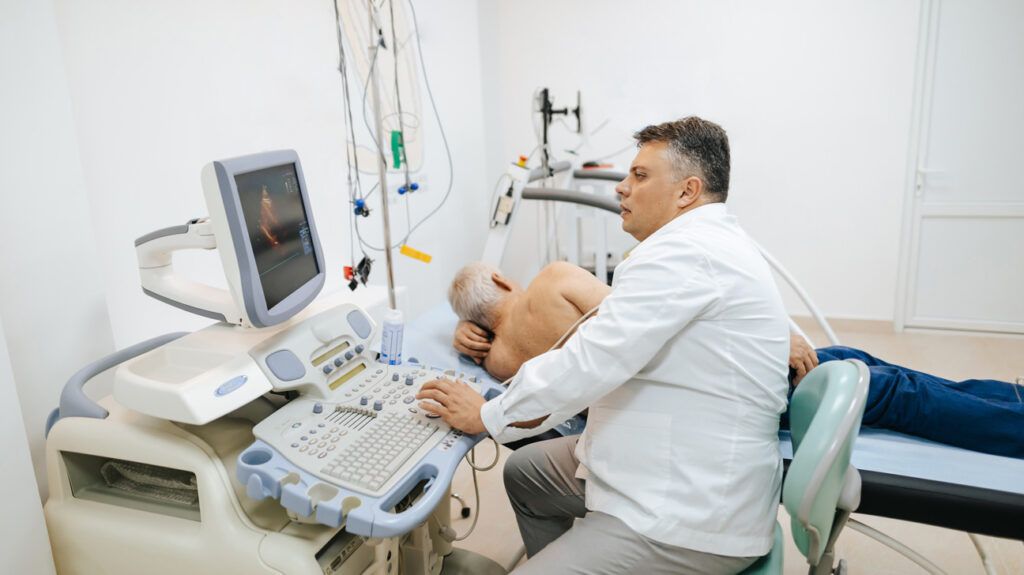Ischemic cardiomyopathy is a secondary condition resulting from coronary artery disease or a heart attack.
Ischemic cardiomyopathy involves a weakening of the heart muscle due to coronary heart disease (CAD) or a heart attack.
Treatment for ischemic cardiomyopathy focuses on the underlying cause.
In this article, we outline what ischemic cardiomyopathy (IC) is, its effects on the body, symptoms, causes and risk factors, diagnosis, and prevention.

IC is a heart condition that occurs when the heart muscle weakens due to CAD or a heart attack.
With CAD, the arteries supplying the heart with blood narrow. This narrowing can prevent essential blood flow to certain areas of the heart, causing damage.
If someone develops IC, their left ventricle will most likely swell and weaken. This inhibits the heart’s ability to pump blood across the body, which can cause heart failure.
A
A person can have early stage heart disease and have no symptoms. However, symptoms of IC can be similar to those of heart failure and include:
- shortness of breath, especially when lying down
- swelling in the legs or abdomen
- fatigue
- exercise intolerance
If CAD begins to affect blood flow, a person
- extreme fatigue
- intolerance to physical activity
- difficulty breathing
- dizziness
- lightheadedness
- fainting
- chest pain or angina
- heart palpitations
- edema, which refers to swelling in the feet and legs
- abdominal swelling
- coughing or wheezing due to the presence of fluid in the lungs
- trouble sleeping
- unplanned weight gain
Anyone with these symptoms should speak with a healthcare professional.
The two leading causes of IC are heart attack and CAD.
Risk factors for developing CAD or having a heart attack
- having a family history of CAD
- high blood pressure
- high cholesterol
- diabetes
- end stage kidney disease
- being sedentary
- history of smoking tobacco
- excessive alcohol consumption
- recreational drug use
Among younger adults, males are generally more likely to develop CAD. In older adulthood, people tend to develop CAD at similar rates.
If someone believes they may have IC, their doctor will most likely refer them to a cardiologist.
A cardiologist will perform an examination and ask the person about their medical history. They may also refer them for further tests,
- Echocardiogram: This imaging test evaluates the heart’s anatomy and function and is typically the first test for diagnosing IC.
- Electrocardiogram: This diagnostic test records the electrical activity of the heart.
- Lipid panel tests: These detect the level of cholesterols and triglycerides in the blood.
- Brain natriuretic peptide test: This test detects a biomarker that the body secretes when the myocardial muscle wall is highly tense.
- Stress test: This test typically requires a person to run on a treadmill or cycle on a stationary bike and monitors the heart’s ability to work under stress.
- Cardiac catheterization: This procedure checks for narrowing of the arteries.
- Myocardial biopsy: This involves taking a small sample of the heart muscle for tissue analysis.
Treating IC involves treating the underlying cause, such as CAD.
To treat CAD, a person’s doctor
- lifestyle changes, such as quitting smoking, eating a balanced diet, and regular exercise
- medications
- surgical interventions
Medications
Doctors may prescribe the following medications to
- statins
- beta-blockers
- angiotensin II receptor blockers
- nitroglycerin patches, sprays, or pills to relax the arteries and relieve chest pain
- angiotensin-converting enzyme inhibitors
- calcium channel blockers
Treatment may also include weakness of the heart, or cardiomyopathy. Individuals should work with their healthcare professionals to create a treatment plan according to their needs.
Without treatment, IC can lead to heart weakness, which can sometimes cause thrombus, or blood clots, and heart failure.
It is crucial that a person receive treatment for the underlying cause of their IC to prevent further complications, including death.
The long-term outlook for a person with IC
- the severity of heart damage
- whether the condition is chronic or acute
- whether treatment is effective or not
- a person’s lifestyle choices
A person has a higher chance of developing complications from IC if they:
- smoke or drink excessive amounts of alcohol
- do not strictly adhere to their medication plan
- do not seek the proper follow-up care
- develop an infection
- have other serious health conditions
Maintaining the following healthy habits
- keeping an eye on blood pressure and cholesterol levels
- eating a balanced diet low in sodium, saturated fat, and cholesterol
- exercising at least 150 minutes per week
- avoiding smoking and recreational drug use
Ischemic cardiomyopathy (IC) is a condition involving a weakening of the heart muscle wall, often due to coronary artery disease (CAD) or a heart attack.
Treatment focuses on addressing the underlying cause and typically consists of a combination of medications, lifestyle changes, and, in some cases, surgery.
People can reduce their risk of developing heart disease, IC, and other heart conditions by not smoking, drinking moderately, eating a balanced diet, and exercising regularly.
